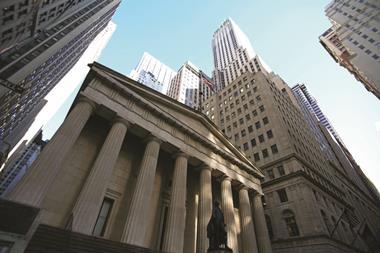European pension funds have welcomed the US Federal Reserve’s decision to raise US interest rates from their near-zero levels, saying the hike and the muted market reaction to it boded well for any return to normal rates in Europe.
As widely anticipated, the Federal Reserve yesterday followed through with a well-flagged interest rate rise, increasing the target for the Fed funds rate by 25 basis points to 0.25%-0.5%.
It is the first time short-term interest rates have been hiked in the US in almost 10 years.
Inger Huus Pedersen, head of fixed income and ESG at Denmark’s PKA, said the market had not reacted very strongly to the new, which she said was reasonable given that “whether the short term rate is 0% or 0.25% doesn’t change many people’s business model fundamentals”.
She welcomed the increase.
“The low-interest-rate environment is a drag on our future returns, and, although there is no hike in sight from the European Central Bank, it is nevertheless a good signal,” she told IPE.
“We were a bit surprised not to see it earlier, but it’s better late than never.”
The Federal Reserve’s move will have no direct near-term implications for the Danish pension fund’s fixed income investment strategy, according to Huus Pedersen, but longer-standing monetary policy divergence could occur.
“In the longer term, if rates stay very low in Europe, and you can achieve higher returns in the US, then we would probably be more likely to look more at US assets,” she said.
In Finland, Timo Viherkenttä, chief executive at VER, the State Pension Fund, its said the Federal Reserve had pulled off a difficult task.
“The Fed was in an uncomfortable situation where the market would probably have reacted negatively both to a more dovish and to a more hawkish measure,” he said.
“Although market impact shouldn’t be the main priority for Fed, they seemed to hit the bull’s eye in this respect.
“In all, the combination of the actual decision and its communication was obviously well thought of and balanced.”
Tom Mergaerts, chief executive at Amonis, the largest pension fund for healthcare workers in Belgium, said he was encouraged by the equity market’s muted reaction to the rate rise and the implications thereof for an eventual return to normal rates in Europe.
“Normally, although not always, interest rate increases are combined with a selloff in equities,” he said. “Clearly, this is not the case this time, at least not yet, and it is a big achievement.”
It is an important and positive sign Europe can return to “normal” interest rates “without going through a trough or crash”, he added.
He attributed the steady market reaction to the advance warning the Federal Reserve had been giving for some time and contrasted it with what happened in 2013, when rumours first surfaced that the central bank would begin to taper quantitative easing.
“Back then, just the rumours the Fed was considering tapering triggered a huge sell-off in the markets,” Mergaerts said. “This week, they raised interest rates, and there was no effect in the markets.”
In the Netherlands, Mercer said the Fed’s decision would not necessarily affect the long-term interest rates relevant for Dutch pension funds’ liabilities.
Drawing on the development of interest rates since 2000, Dennis van Ek, an actuary at the consultancy, pointed out that long-term rates, such as the 30-year swap rate, did not always respond to adjustments of short-term rates by central banks.
“Even if long-term rates in Europe rise as a consequence of the Fed’s decision, the European Central Bank is likely to take additional measures to keep rates low over here because of its inflation target of 2%, as the ECB has already indicated,” he said.
His assessment was echoed by Sander van Ginkel, chief economist at the €110bn MN, the fiduciary manager for the large metal schemes PME and PMT.
He said “some” upward pressure on interest rates in Europe would come no sooner than the second half of 2018.
He added that MN had already factored the Fed’s increase into its base-case investment scenario, and that the fiduciary manager saw no need for portfolio adjustments at the moment.
Van Ginkel said markets had responded positively to the Fed’s decision, with equity markets improving and volatility indices, such as the VIX, declining.
He said he expected the Fed to have increased interest rates to approximately 3% by the end of 2017, but he warned of the risk of volatility somewhere along the way “if the markets, which currently expect a slower increase, start catching up”.
Mercer’s Van Ek noted that some investments and investment funds – such as funds for US property and mortgages, as well as hedge funds – could be affected by a higher interest burden, “as this will have an impact on companies’ ability of paying back”.
According to the actuary, liquidity problems have recently emerged at some high-yield funds and hedge funds.
“Pensions funds with a stake in these investments should monitor developments closely,” he said.







No comments yet